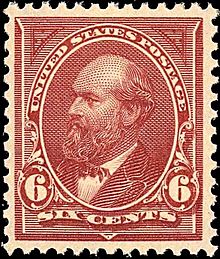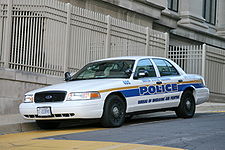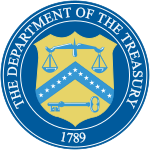Bureau of Engraving and Printing
 Seal of the Bureau of Engraving and Printing | |
 | |
| Agency overview | |
|---|---|
| Formed | August 29, 1862[1] |
| Headquarters | 300 14th St SW Washington, D.C., U.S. |
| Employees | 2,169 (2006) |
| Agency executive | |
| Parent agency | Department of the Treasury |
| Website | www.bep.gov |
The Bureau of Engraving and Printing (BEP) is a
History


The Bureau of Engraving and Printing has its origins in legislation enacted to help fund the
Initially, the currency processing operations in the Treasury were not formally organized. When Congress created the Office of Comptroller of the Currency and National Currency Bureau in 1863, currency-processing operations were nominally subordinated to that agency and designated the "First Division, National Currency Bureau". For years, however, the currency operations were known by various semi-official labels, such as the "Printing Bureau", "Small Note Bureau", "Currency Department", and "Small Note Room". It was not until 1874 that the "Bureau of Engraving and Printing" was officially recognized in congressional legislation with a specific allocation of operating funds for the fiscal year of 1875.
From almost the very beginning of its operations, the Bureau of Engraving and Printing designed and printed a variety of products in addition to currency. As early as 1864, the offices which would later become the BEP made passports for the State Department and money orders for the Post Office Department. Passports are now produced by the Government Publishing Office. Other early items produced by the BEP included various government debt instruments, such as interest-bearing notes, refunding certificates, compound interest Treasury notes, and bonds. The production of postage stamps began in 1894, and for almost the next century the BEP was the sole producer of postage stamps in the country.
-
The BEP in Washington, D.C.
-
15th Street SW entrance to the BEP in Washington, D.C.
-
13th Street SW entrance to the BEP Annex in Washington, D.C.
-
The Bureau's Fort Worth location, with visitor tours available during business hours.
Production

1st postage stamp printed by BEP
Postage stamp production
The Bureau of Engraving and Printing officially took over production of postage stamps for the United States government in July 1894. The first of the works printed by the BEP was placed on sale on July 18, 1894, and by the end of the first year of stamp production, the BEP had printed and delivered more than 2.1 billion stamps. The United States Postal Service switched purely to private postage stamp printers in 2005, ending 111 years of production by the Bureau.[3][4] Starting in 2011 the United States Postal Service in-housed all postage stamp printing services.
Currency production

Plate capacity on power presses increased from four to eight notes per sheet in 1918 in order to meet the greatly expanded production requirements related to World War I.
With the redesign of
A further increase in the number of notes per sheet was realized in 1952 after breakthrough developments in the production of non-offset inks. Beginning in 1943, the BEP experimented with new inks that dried faster, therefore obviating the need to place tissues between sheets to prevent ink from offsetting to other sheets. The faster drying ink also enabled printed sheets of backs to be kept damp until the faces were printed, thereby reducing distortion caused by wetting, drying, and re-wetting of the paper (sheets needed to be dampened before each printing).

By reducing the distortion that increases proportionally with the size of the sheet of paper, the Bureau was able to convert from 12-note printing plates to plates capable of printing 18 notes in 1952. Five years later in 1957, the Bureau began printing currency via the dry
During
Locations
The Bureau of Engraving and Printing has two locations: one in Washington, D.C., and another in Fort Worth, Texas.
District of Columbia location
The Washington facility consists of two adjacent buildings. The elder, considered the main building and located between 14th and 15th streets SW, was constructed in 1914.
In May 1938, work was completed on an addition to the Washington, D.C., facility to accommodate increases in
The Washington, D.C., location offers a free 30-minute guided tour which features the various phases of currency production. Tours may be taken Monday through Friday. The Bureau is closed for all federal holidays and the week between Christmas and New Year's Day.[7][8]
Fort Worth location
In 1987, construction began on a second facility in
Historic locations
The Bureau moved into its own building in 1880 with the completion of a facility at 14th St. and Independence Ave. SW, now the
Future locations
On April 27, 2022, Maryland Governor Larry Hogan announced that the BEP would move from their historic Washington, D.C. location to Beltsville, MD at the U.S. Department of Agriculture's Beltsville Agricultural Research Center (BARC). The U.S. Department of Treasury was transferred ownership of 114 acres within BARC from the Department of Agriculture for a future facility estimated to be completed in early 2027.[10]
BEP Police

The Bureau operates a police department, the Bureau of Engraving and Printing Police Force, that protects BEP personnel and facilities. The BEP Police are responsible for enforcing federal and local laws, Treasury Department rules and regulations, Washington, DC Criminal Code through a Memorandum of Understanding, and Texas Criminal Code.[11] In 2004, 234 Police officers were employed.[12]
See also
- US Treasury specimen book
- Charles R. Chickering, chief stamp designer for BEP
- Federal Reserve System
- Title 31 of the Code of Federal Regulations
- United States Mint Police
- United States Treasury Police
- Who's Minding the Mint?, a 1967 film with the D.C. Bureau of Engraving and Printing as its setting
References
- ^ Treasury.gov Archived December 26, 2007, at the Wayback Machine
- ^ "U.S. Currency". Bureau of Engraving and Printing U.S. Department of the Treasury. Retrieved March 29, 2017.
- ^ McAllister, Bill (13 June 2005). "After 111 Years, Postage Stamps Go Private". Washington Post. Retrieved 9 April 2012.
- ^ "2005 Comprehensive Statement on Postal Operations". USPS. Retrieved 9 April 2012.
- ^ Bureau of Engraving and Printing. "Annual Production Figures" Archived 2011-08-27 at the Wayback Machine, referenced 2014-03-11.
- ^ Latimer, Louise Payson (1924). Your Washington and Mine. Charles Scribner's Sons. p. 162.
- ^ "Washington, D.C. -- Places To Tour -- Bureau of Engraving and Printing".
- ^ "Bureau of Engraving and Printing". Yelp. 8 November 2015.
- ^ "USPaperMoney.Info: Features of Current Notes".
- ^ "Governor Hogan Announces U.S. Bureau Of Engraving And Printing Moves Forward With New Production Facility In Maryland". Governor of Maryland. Retrieved 2022-04-28.
- ISBN 978-1435480537.
- ^
Reaves, Brian A. (July 2006). "Federal Law Enforcement Officers, 2004" (PDF). Bureau of Justice Statistics. Archived (PDF) from the original on 2020-08-26.
{{cite journal}}: Cite journal requires|journal=(help)





